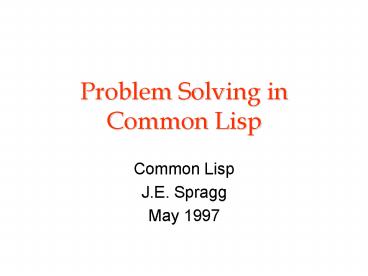Problem Solving in Common Lisp PowerPoint PPT Presentation
Title: Problem Solving in Common Lisp
1
Problem Solving in Common Lisp
- Common Lisp
- J.E. Spragg
- May 1997
2
The Problem Space Model
- People seem to handle adequately the notion of
physical space. - It seems natural to extend our notions of
physical space and use it as a topological
metaphor for problems and problem solving. - The problem space model of problems and problem
solving makes use of the ideas of location,
shape, and distance that are so useful in
reasoning about physical space.
3
Problem Space
- A problem space is a set of states that represent
distinct configurations of the objects and
relationships of the domain. - And a set of operators which define how to move
between states. - Operators typically have parameters.
4
Defining a Problem Space
- Defining a problem in a given problem space
requires two things - an initial state
- a goal
- The initial state is a distinguished state that
represents the starting point within the space. - The goal is a specification of the subset of the
problem space which could serve as a solution to
the problem.
5
Solving Problems
- Solving a problem in this model is accomplished
by finding a sequence of operators which, when
applied to the initial state, allows one to reach
a state satisfying the goal criterion. - In the Blocks World example, the solution is a
sequence of transformations that represent a
legal plan.
6
Search
- It is easy to see why this is an attractive model
of problem solving. - To solve a problem, all we have to do is define
the problem space and then unleash a
general-purpose search engine on it.
7
Classic Problem Solving Systems
- The design of a classic problem solver consists
of two parts - an interface for user-supplied problem spaces,
and a - search engine.
8
Interface
- The interface requires the ability to manipulate
states and operators. - What kinds of manipulations are needed?
- Goal detection Ascertain whether a given state
satisfies the goal criterion. - State identity Detect when two descriptions of
states refer to the same state. - State display Produce a human readable
description of a given state.
9
- The importance of goal detection is obvious.
- State identity is important because we make no
progress by re exploring already examined states. - Displaying states allows us to observe and debug
system behaviour.
10
Expanding a State
- Identify what operators are available.
- Determine whether a given operator is applicable
to a particular state. - Given a state and an operator applicable to it,
ascertain all the ways the operator can be
instantiated on that state. - Figure out what new state results from applying
an instantiated operator to a state.

